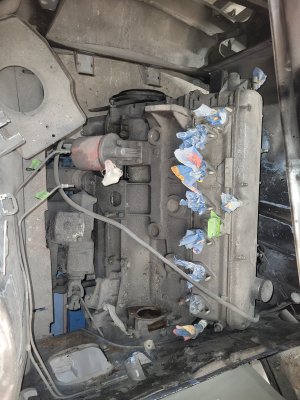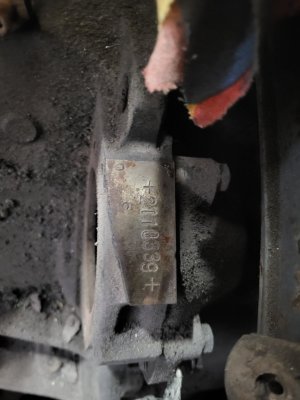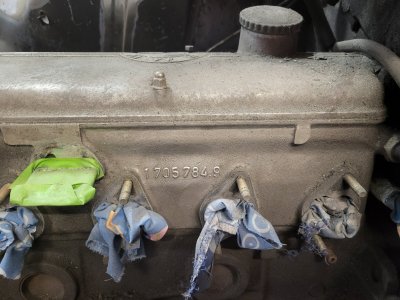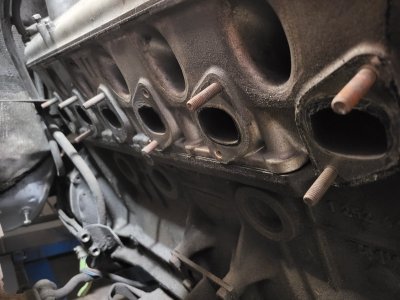I am in need of some assistance.
I am at this point, and I'm a bit puzzled how to proceed with 'engine things'.
The engine needs to come out to fix my body properly, so I want to "do the engine" while I am in there.
The thing is, I have little knowledge on how to determine what needs to be done on my engine, nor what makes sense to do, or skip
An engine shop could easily fool me.... And I do not like to be in that position.
But i have 2 capable hands, and I have you guys!
My target:
I would like to achieve : 1. Durability for ~50.000km, 2. Reach at least the 180Hp it left the factory with, 3. Keeping the Carbs and 4. have the appearance of a period correct engine,
IF it needs it, then I am OK to sink 5K into it, but I'd like to do as much as i can myself, to enjoy it, learn, and keep my money for skiing trips & a decent paint job.
Timing wise... it needs to be ready when I've fixed the front end of my car + having it completely painted. As i am bloody slow, this means plenty of time.
How did it ran (10 years ago...)
I've covered about 17.000 kms with it (~10.000 miles) over the 4 years that i drove it as a daily. I parked it in 2015. I've only filled the oil, checked gaps, replaced spark plugs and set the points. It ran quite OK-isch, I'm guessing with about 120-140 HP. It topped out at max 170km/hour (105 miles/hour) but it was eating oil (1 liter every 2000 km's _ 1/3 gallon every 1200 miles). When letting go of the gas at highway speeds, the tailpipe emitted a nice blue smoke, which I've learned means valve seals likely need replacement. Also it's fuel consumption was about double that of the factory specs, but i am assuming it was likely bad carbs. Upon removing the 2 aluminum air intake manifolds, I noticed the inlet gaskets were not correct for the mating surfaces, showing paths were dirty air was drawn into at least 2 cylinders (pic linked here https://e9coupe.com/forum/attachments/20211112_004632-jpg.130481/ ) . The engine is not numbers matching, coming of an E3. The engine number is 2110339; it also has 3.0 stamped on it I think. Realoem links this number to a E3; 3.0S Euro, Automatic from October '73. The head has been replaced as well; (see pics) it is dated 87, and it has the later intake ports.
That's all I know about the engine.
I have already sourced a 5speed and 3.45 LSD, both of unknown state. However to keep (some) speed in the resto, I'll likely build the car up as it was, automatic, and convert to 5spd/LSD whenever i feel the need in 5 or 10 years from now. The block has been drained from coolant 10 years ago (so it sat for about 3 years with coolant), and oil was poured on top of the cylinders. It still rotates by hand on the flywheel. Only the automatic gearbox is still attached and the oil filter, and it's in the car still.
Now, How to dive in?
Ideally:
I'd pull it all apart myself, measure what's good / not good, and then go to an engine builder to get fixed what is needed, having the knowledge of what's OK&NOK, and what it should be after paying the bill to call it a success.
Please hit me with all your pointers, tips, tricks and pitfalls.
I am at this point, and I'm a bit puzzled how to proceed with 'engine things'.
The engine needs to come out to fix my body properly, so I want to "do the engine" while I am in there.
The thing is, I have little knowledge on how to determine what needs to be done on my engine, nor what makes sense to do, or skip
An engine shop could easily fool me.... And I do not like to be in that position.
But i have 2 capable hands, and I have you guys!
My target:
I would like to achieve : 1. Durability for ~50.000km, 2. Reach at least the 180Hp it left the factory with, 3. Keeping the Carbs and 4. have the appearance of a period correct engine,
IF it needs it, then I am OK to sink 5K into it, but I'd like to do as much as i can myself, to enjoy it, learn, and keep my money for skiing trips & a decent paint job.
Timing wise... it needs to be ready when I've fixed the front end of my car + having it completely painted. As i am bloody slow, this means plenty of time.
How did it ran (10 years ago...)
I've covered about 17.000 kms with it (~10.000 miles) over the 4 years that i drove it as a daily. I parked it in 2015. I've only filled the oil, checked gaps, replaced spark plugs and set the points. It ran quite OK-isch, I'm guessing with about 120-140 HP. It topped out at max 170km/hour (105 miles/hour) but it was eating oil (1 liter every 2000 km's _ 1/3 gallon every 1200 miles). When letting go of the gas at highway speeds, the tailpipe emitted a nice blue smoke, which I've learned means valve seals likely need replacement. Also it's fuel consumption was about double that of the factory specs, but i am assuming it was likely bad carbs. Upon removing the 2 aluminum air intake manifolds, I noticed the inlet gaskets were not correct for the mating surfaces, showing paths were dirty air was drawn into at least 2 cylinders (pic linked here https://e9coupe.com/forum/attachments/20211112_004632-jpg.130481/ ) . The engine is not numbers matching, coming of an E3. The engine number is 2110339; it also has 3.0 stamped on it I think. Realoem links this number to a E3; 3.0S Euro, Automatic from October '73. The head has been replaced as well; (see pics) it is dated 87, and it has the later intake ports.
That's all I know about the engine.
I have already sourced a 5speed and 3.45 LSD, both of unknown state. However to keep (some) speed in the resto, I'll likely build the car up as it was, automatic, and convert to 5spd/LSD whenever i feel the need in 5 or 10 years from now. The block has been drained from coolant 10 years ago (so it sat for about 3 years with coolant), and oil was poured on top of the cylinders. It still rotates by hand on the flywheel. Only the automatic gearbox is still attached and the oil filter, and it's in the car still.
Now, How to dive in?
- Do i just take the parts of the engine one by one, out of the engine bay, and measure stuff (what?)?
- It doesn't have the starter motor mounted anymore, so doing compression testing would require me to source a new starter and mount it with a spare battery. Would that provide valuable info & warrant to spend the time to buy & mount it? I do have compression numbers somewhere from when i bought it in 2012...Do they still carry any value?
- If I hoist the engine out and drop it off at a classic car engine builder, is it generic enough that they will just know what to do with it?
Ideally:
I'd pull it all apart myself, measure what's good / not good, and then go to an engine builder to get fixed what is needed, having the knowledge of what's OK&NOK, and what it should be after paying the bill to call it a success.
Please hit me with all your pointers, tips, tricks and pitfalls.
Attachments
Last edited:







